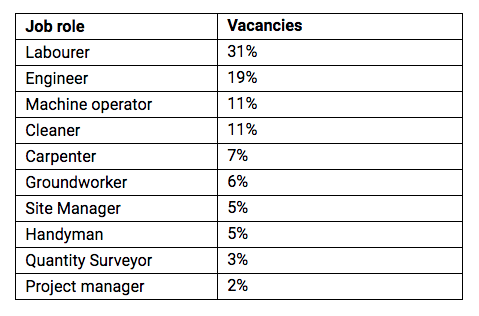Owen Goodhead, chief operating officer at Randstad, comments, “2020 was a turbulent year for the construction industry. The UK has just left the European Union and while a deal has been struck, companies are having to navigate additional red-tape when accessing supplies and labour from the EU. A combination of Brexit and Covid-19 has also seen some EU-born workers return to home countries. The dual impact of Covid-19 and Brexit has caused real uncertainty in the market, as it has across the wider world.
“Despite today’s data showing a 5% increase in overall unemployment in the three months to November, the construction sector continues to demonstrate its resilience, establishing itself as one of the bright spots of the economy, and one of only three sectors to show an increase in vacancies. Recent research we’ve produced reinforces this and shows that infrastructure and housing delivery is a driving force in the economy with close to 60,000 projects expected to progress this year and today’s vacancies data reflects this, showing an increase in vacancies to 28,000. There is a wealth of opportunity here for skilled workers to seize the jobs being created; our data shows that labourers, engineers and machine operators are currently the most in-demand across the construction, property and engineering sector, representing a real opportunity for quality candidates.”
Randstad recently released a research report looking at project pipelines, average construction salaries and most in-demand roles, the research found that:
- Construction salaries decreased 2% in 2020 to an average of £44,115.
- Between 2016 and 2020 salaries have increased by 12% on average.
- Despite the Government’s current levelling up agenda, a majority of infrastructure and housing projects are planned for the South East (20,986), with the least planned for the North East (6,116).
- Labourers, engineers and machine operators are currently the most in-demand across the construction, property and engineering sector.
- Of the top ten most in-demand roles Randstad is seeing, a third of vacancies are for labourers.
Today the ONS employment figures showed that:
- The UK unemployment rate, in the three months to November 2020, was estimated at 5.0%, 1.2 percentage points higher than a year earlier and 0.6 percentage points higher than the previous quarter.
- Vacancies in the construction industry have increased to 28,000 (Link to latest vacancies data)
- Unemployment in the construction industry was at 73,439 Sept to Nov 2020
Randstad mind the gap report – analysis of current live vacancies in the construction sector:

